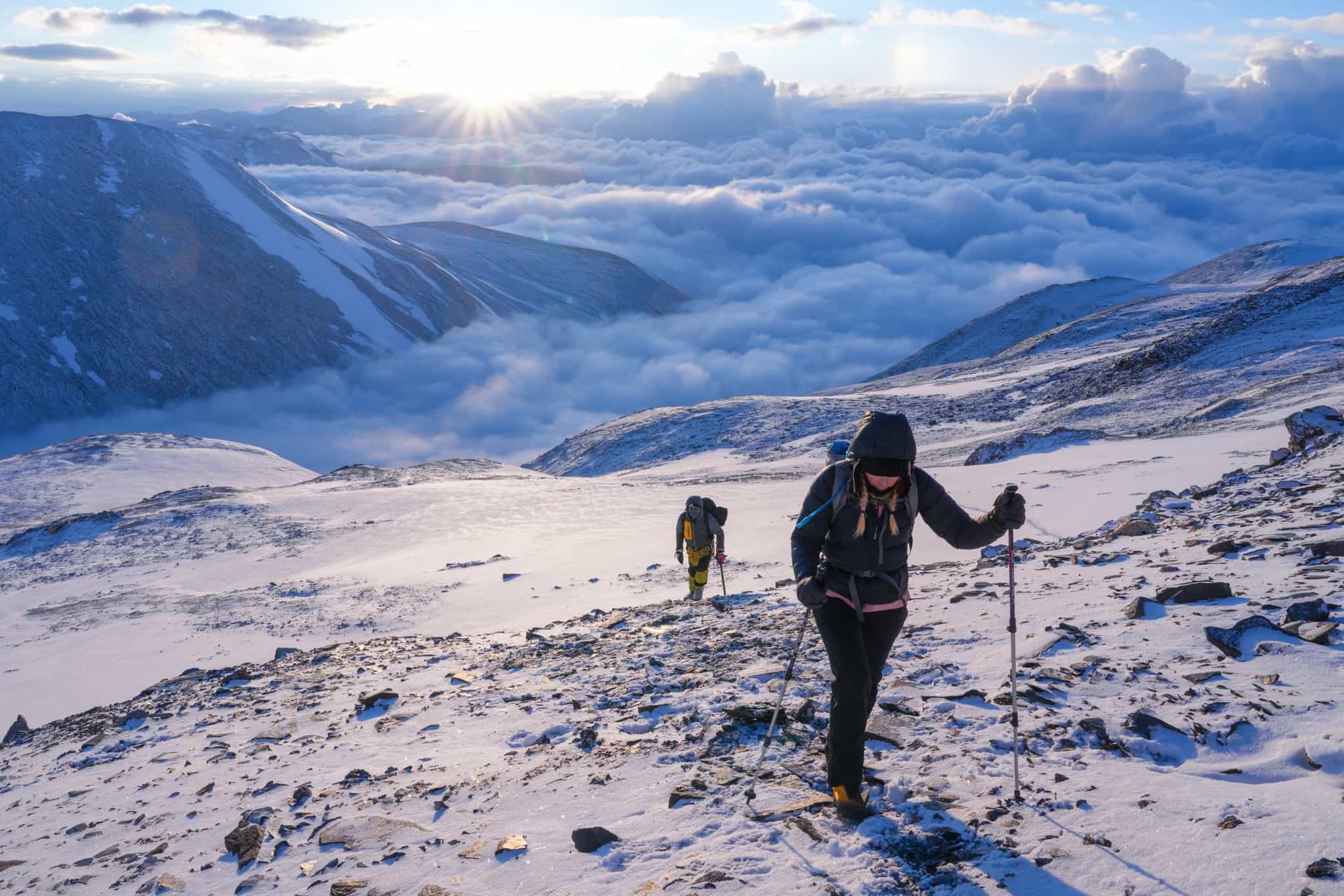
Trek India's Markha Valley to Summit UT Kangri (6070m)
Trek through Ladakh, northern India’s ‘Land of the High Passes’, before tackling a challenging Himalayan trekking peak over 6000m high
What's Included?
Activities & Certified Guides
All itinerary activities with expert, local, English-speaking guidesHotels and Camping
4 nights in hotels and 9 nights campingMeals
All breakfasts, 10 lunches, and all dinnersInternal Flights and Transfers
Internal flights to & from Leh; all airport and ground transfers. Pack horses will carry your overnight luggage on the trek.Equipment and Permits
All climbing equipment (except boots) plus tent and mattress. All entrance fees and permits are taken care of.Small Like-minded Groups
Solo-friendly by design, join our small n’ sociable groups of up to 12 like-minded, active and outdoorsy people…
…
What's it like?





























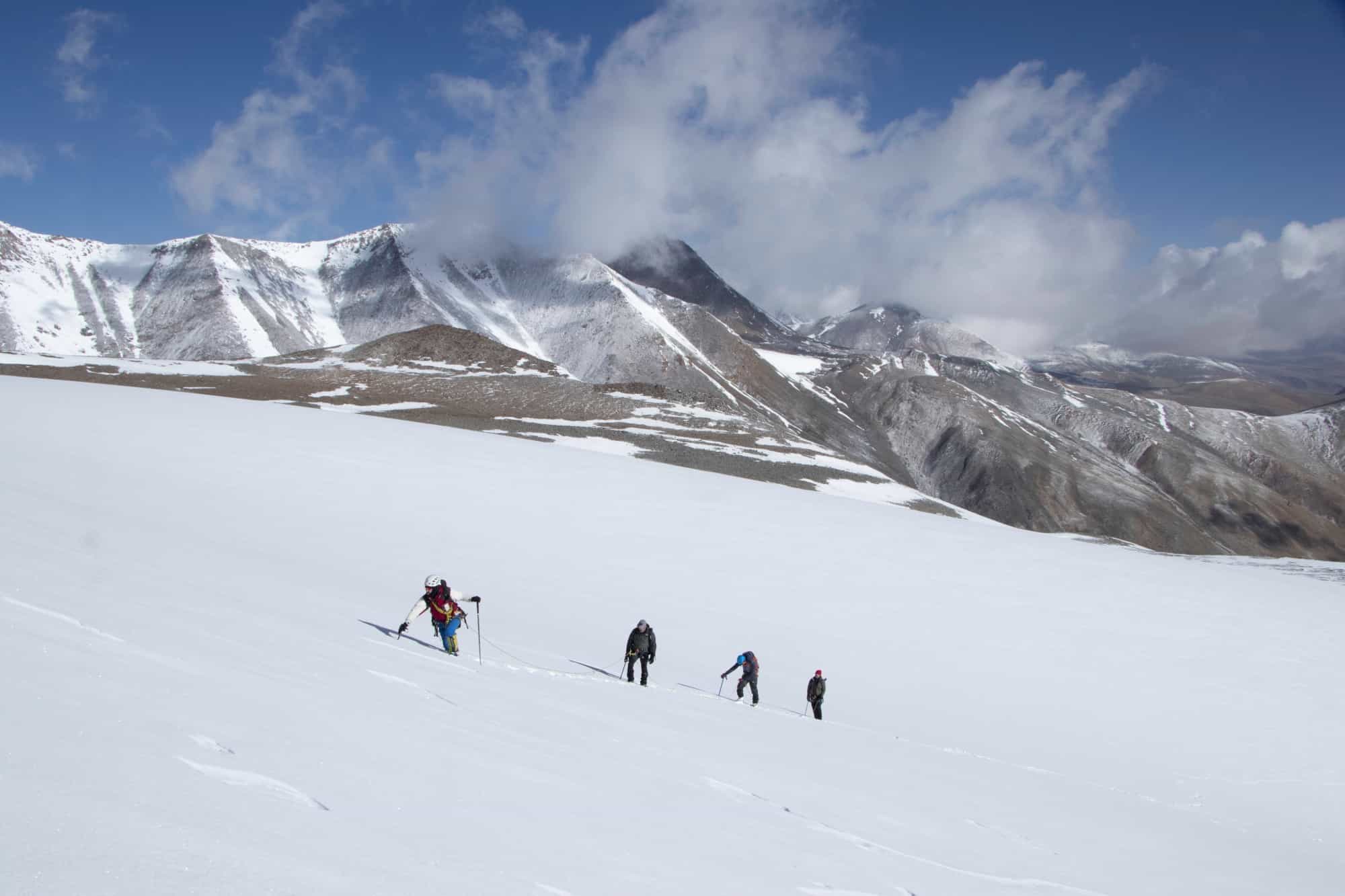
Tales from the trails
Real people, real adventures.
Trek through the spectacularly remote Markha Valley with its high-altitude desert, wild pasturelands and ancient Buddhist monasteries
Learn the skills needed to navigate high-altitude mountain terrain, surrounded by the lofty Himalayan peaks of Kang Yatse and Dzo Jongo
Bask in the achievement of bagging UT Kangri’s 6070m summit on a pioneering route, developed by expert Ladakhi mountain guides
Experience the unique Himalayan Buddhist culture of Ladakh, dotted with hilltop monasteries, mystic chortens and remote mountain villages
Key Information
Day 1
Welcome to Delhi!
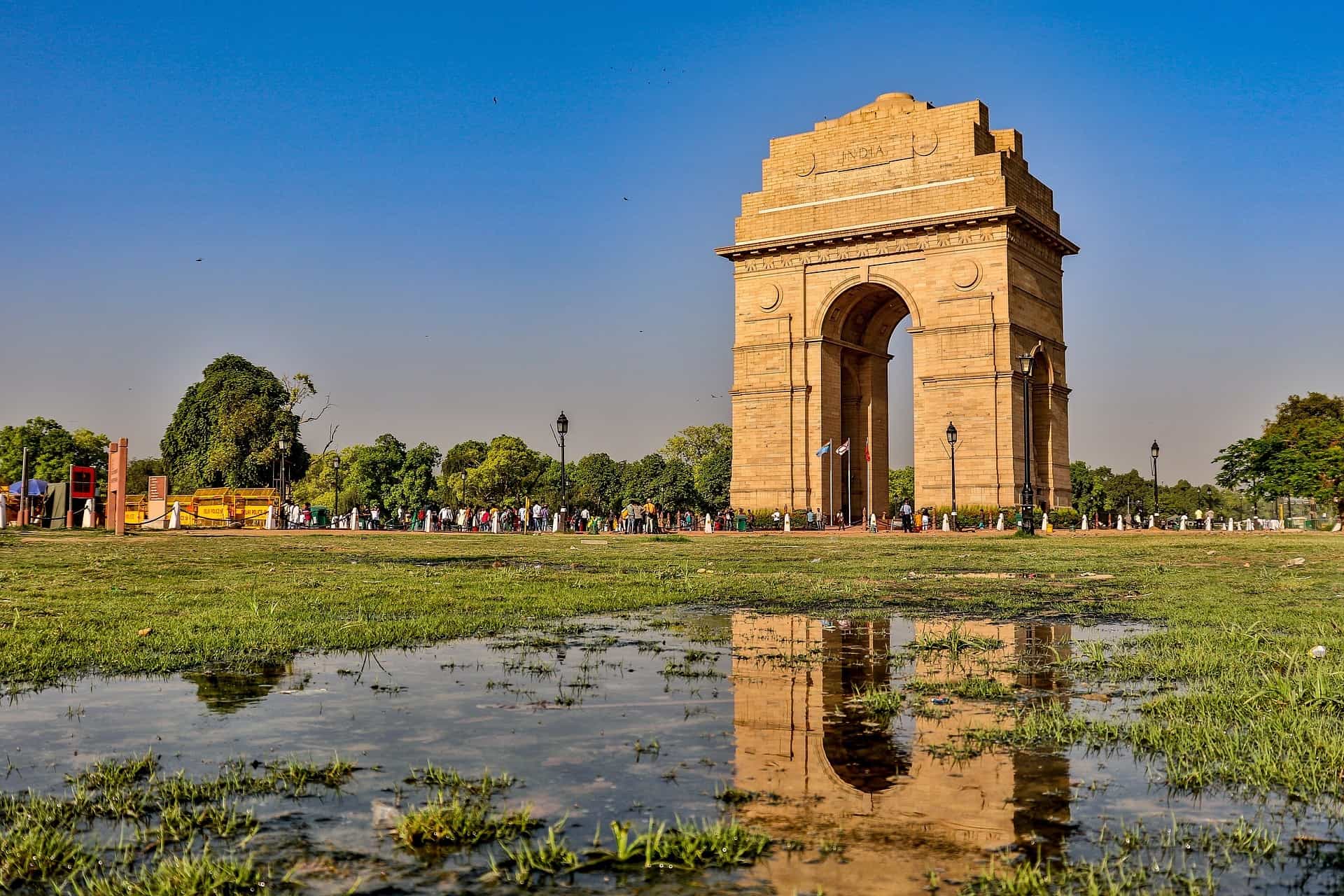
Meet your host at the airport in Delhi, and settle in for the transfer across town to your hotel in the centre. Depending on your arrival time, you may have time to head out and explore some of Delhi's sights before getting to know your fellow travellers over dinner.
Day 2
Fly to Leh and meet your trek crew

Jump on a morning flight from Delhi to Leh – eyes peeled for your first glimpse of the snow-capped Himalayas from above, as you travel to the far north of India. Accompanied by your guide you'll arrive in the historic capital of Ladakh to start your adventure. With centuries of rich heritage and cross-cultural exchange, Leh is a traveller's delight, bursting with ancient Tibetan monasteries, bustling bazaars, enchanting alleyways adorned with colourful prayer flags, quaint guesthouses and small cafes. You'll be taken to your hotel where you'll meet your local trek crew and have the rest of the afternoon to relax or explore the town as your body slowly adapts to Leh's high altitude.
Day 3
Acclimatisation in Leh

Hiking
Having flown into Leh at 3500m, today is an important day for acclimatisation. You'll begin the day with a briefing on high-altitude trekking from your mountain guides; they'll give you an idea of what to expect and how best to approach the upcoming trek. Then take a look around Leh with your guides before a two-hour acclimatisation walk up to the hilltop Thiksey Monastery, Ladakh's most iconic building. Explore the temples and meet the red-robed monks who live in the monastery, before returning to your hotel in Leh.
Day 4
Into the Markha Valley
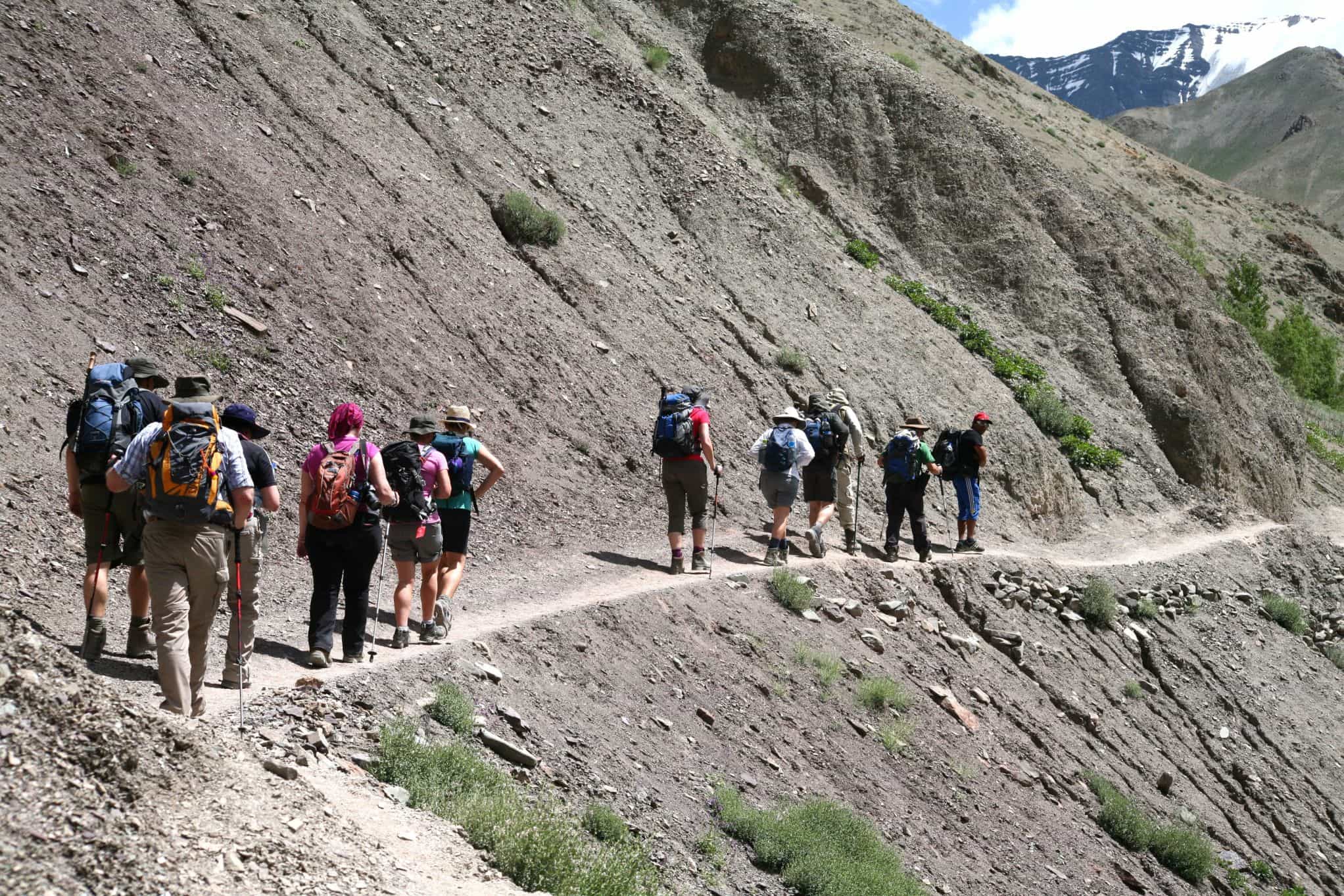
Driving
Hiking
Time to head for the mountains! Jump in the van for a drive up to the village of Sara at the head of the Markha Valley. Tuck into lunch under the shade of the 'tea tent' before beginning your trek along the valley, through the settlement of Chalak, and on to camp at the small hamlet of Thinles Pa (3700m). It's an easy first day on a good trail, giving you plenty of opportunities to take in the magnificent Himalayan scenery. As the trek unfolds, you'll find yourself sleeping in progressively more remote camps, allowing you to disconnect from modern comforts and digital connections and immerse yourself in the epic natural surroundings. Tranquil mornings and evenings will present you with the most breathtaking views of softly lit mountains towering above, endless panoramic vistas and chance encounters with the local wildlife.
Day 5
Thinles Pa to Hankar (4250m)
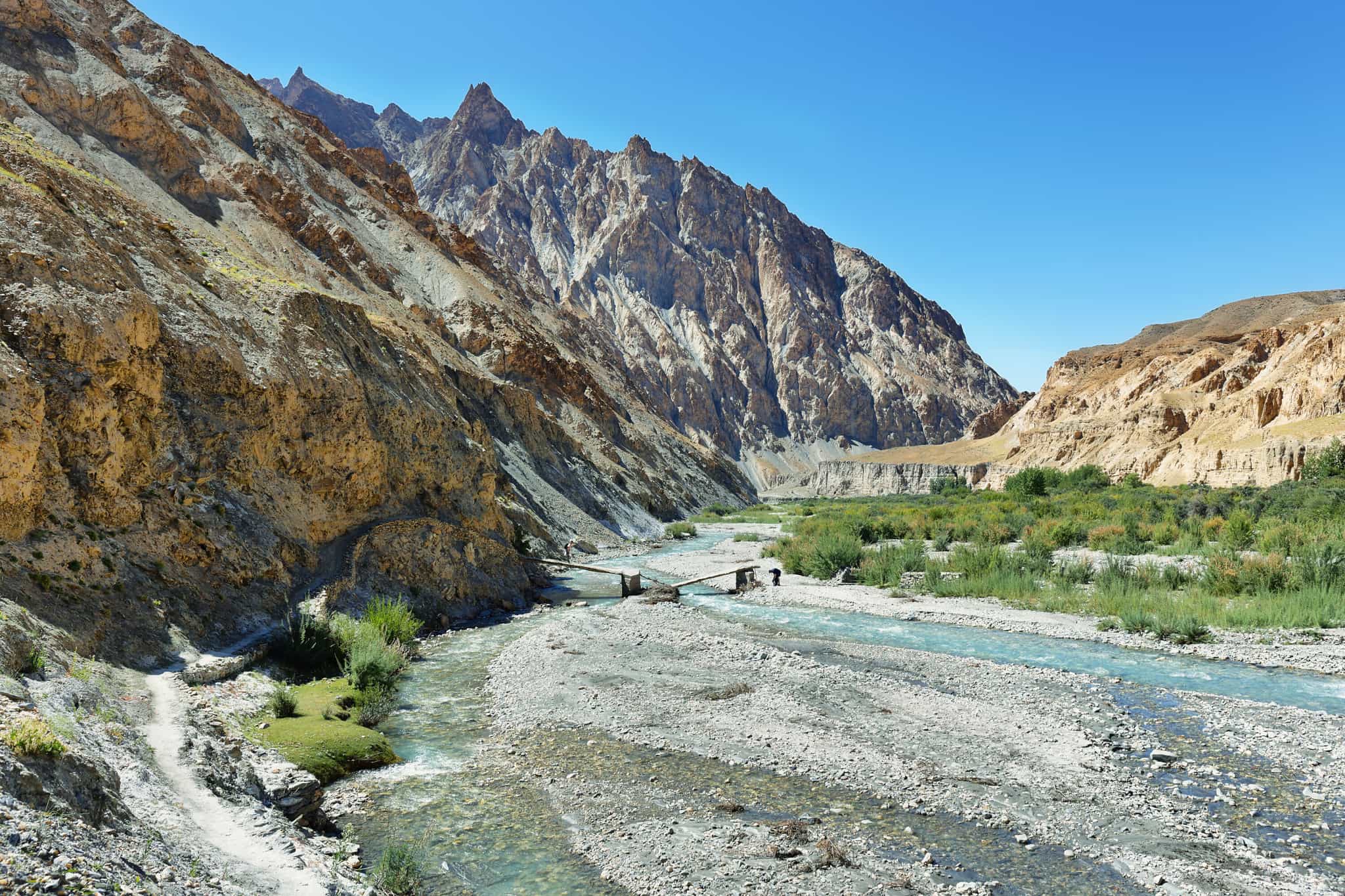
Hiking
Today's route crisscrosses the river at the valley floor on its way up to the remote village of Markha. Not all crossings have useable bridges, so enjoy the chance to dip your feet in the cool Himalayan waters. Continue along an impressive line of 'chortens' – these holy structures of Tibetan Buddhism stretch for miles across the Ladakh landscape. They are believed to ward off evil spirits, aided by the mounds of goat horns placed on top! Stopping in Markha, you'll witness the remote way of life and crumbling structures that hint at a time when the valley was more populated. Continue on the trail, stopping off at the precariously positioned Tache Gompa, another stunning Buddhist monastery perched on a seemingly inaccessible cliff top but reached via a short, steep climb. Admire the incredible views down the valley before continuing on, passing more small villages as you climb up a side valley to the ruins of Hankar Fort before descending into the Upper Hankar to the stream-side camp. Stunningly remote, the camp here is often shared with the resident Himalayan blue sheep.
Day 6
Hankar to Nimaling (4854m)
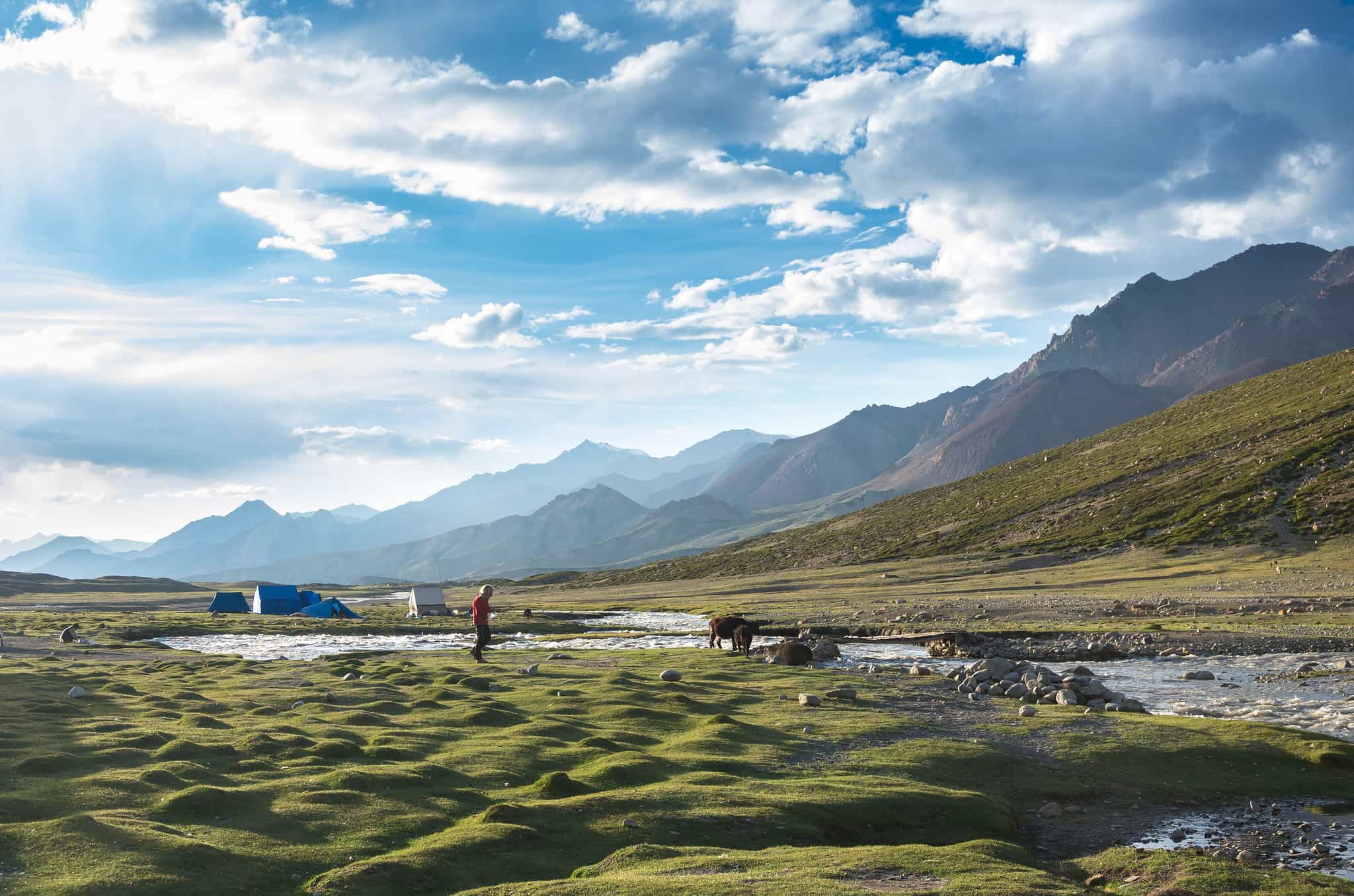
Hiking
Today you will trek a short but tough route to reach Nimaling. The trail will climb steeply to a plateau where the valley opens out. Witness the spectacular views of Kang Yatse (6400m), the highest peak in the valley. People do not live permanently in this region; however, during the summer months, the shepherds bring their flocks of goats, sheep and dzos (a hybrid of cow and yak) to graze on the pastures. In summer, the shepherds stay in stone shelters – you can often buy yoghurt or local cheese from them. Reach Nimaling by lunchtime and your trek crew will set up the camp. In the afternoon, there is time to explore the Kang Yatse region behind the campsite as further acclimatisation. As darkness falls, raise your eyes to the sky for some epic stargazing away from any light pollution.
Day 7
Nimaling to Chak-tsang (4700m)
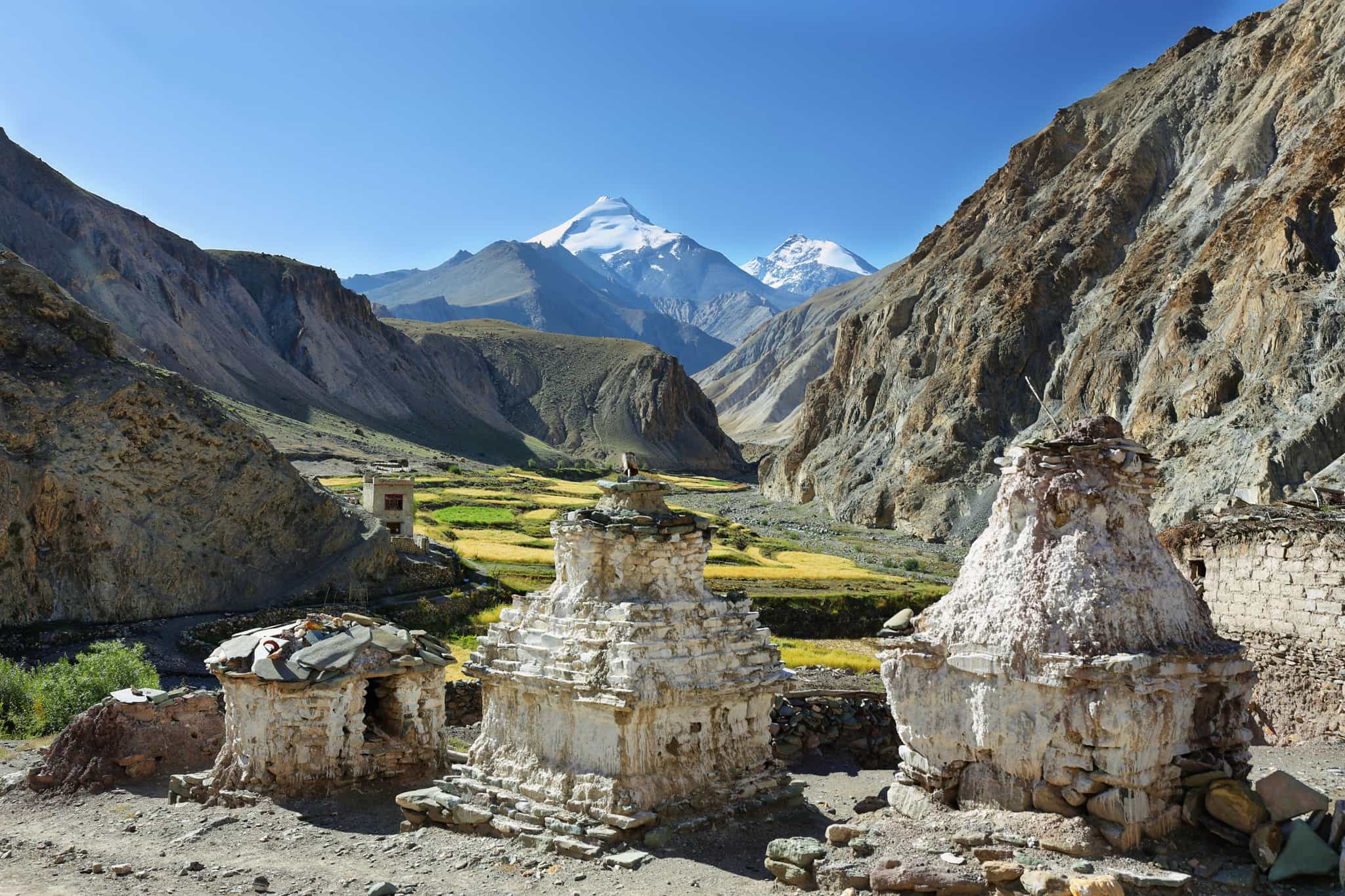
Hiking
Begin today with a tough climb over the high pass of Lalung La (5300m), with jaw-dropping views of the snow-topped peaks of two six-thousanders, Dzo Jongo and Kang Yatse, as your reward. Look out for the high-altitude glaciers that are the main water source for the people of the Markha Valley. Descending the other side of the pass you'll cross grazing land for yak and other cattle dotted with abandoned nomadic huts before reaching camp at Chaktsang.
Day 8
Chaktsang to Lato (4000m)
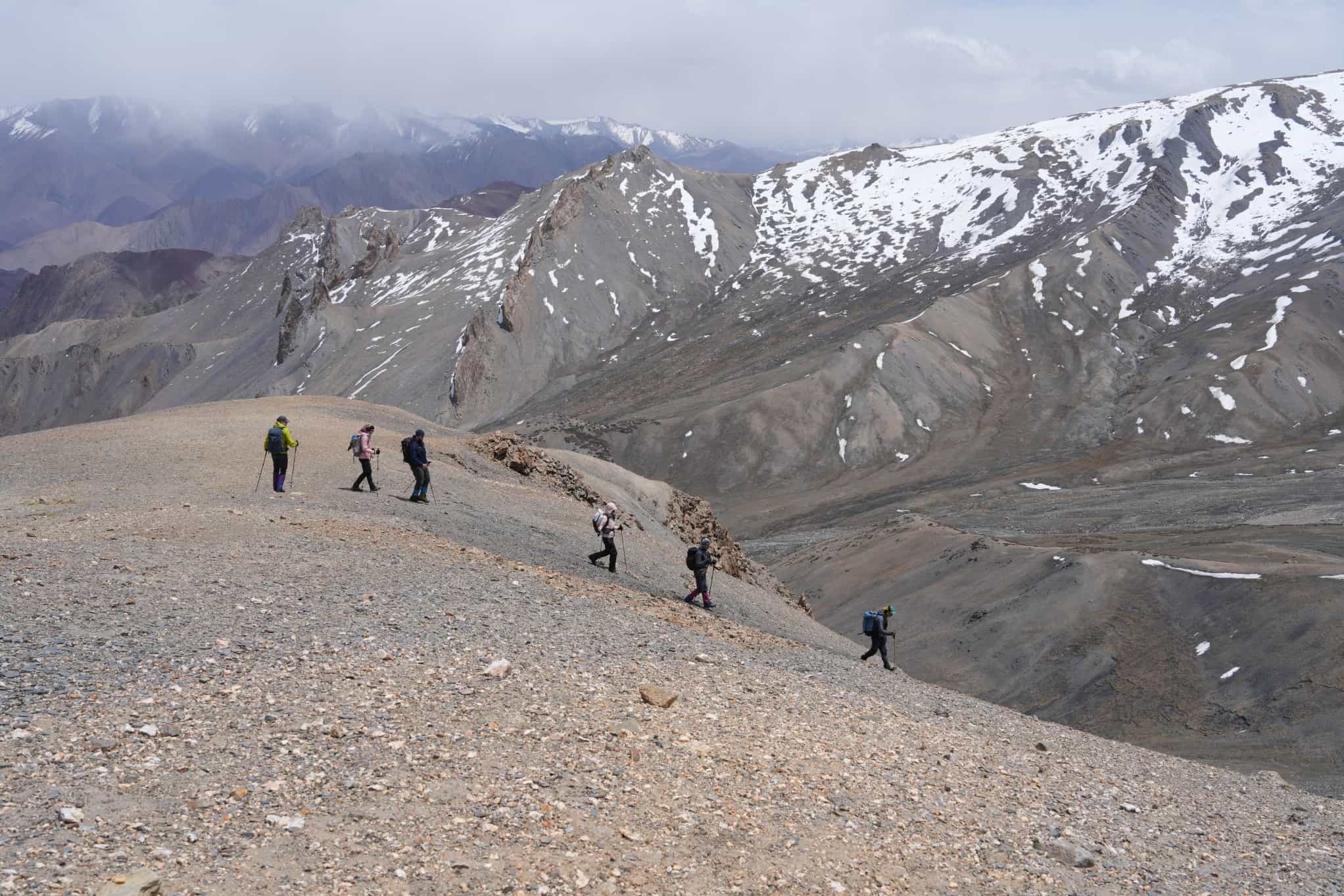
Hiking
Another tough day of up and down awaits. Start with a steep descent into a beautiful valley lined with impressive rock formations, then ascend steeply over the Chaksang La Pass (5200m) before heading down towards the village of Lato and the valley from which you will approach UT Kangri. You have now left the traditional Markha Valley trail and have several days of quieter paths where you'll be joined only by nomadic herders and intrepid mountaineers. Tonight's camp is situated on the Kyamur River on the quiet outskirts of Lato village.
Day 9
Lato to Rumtse Phu (4854m)
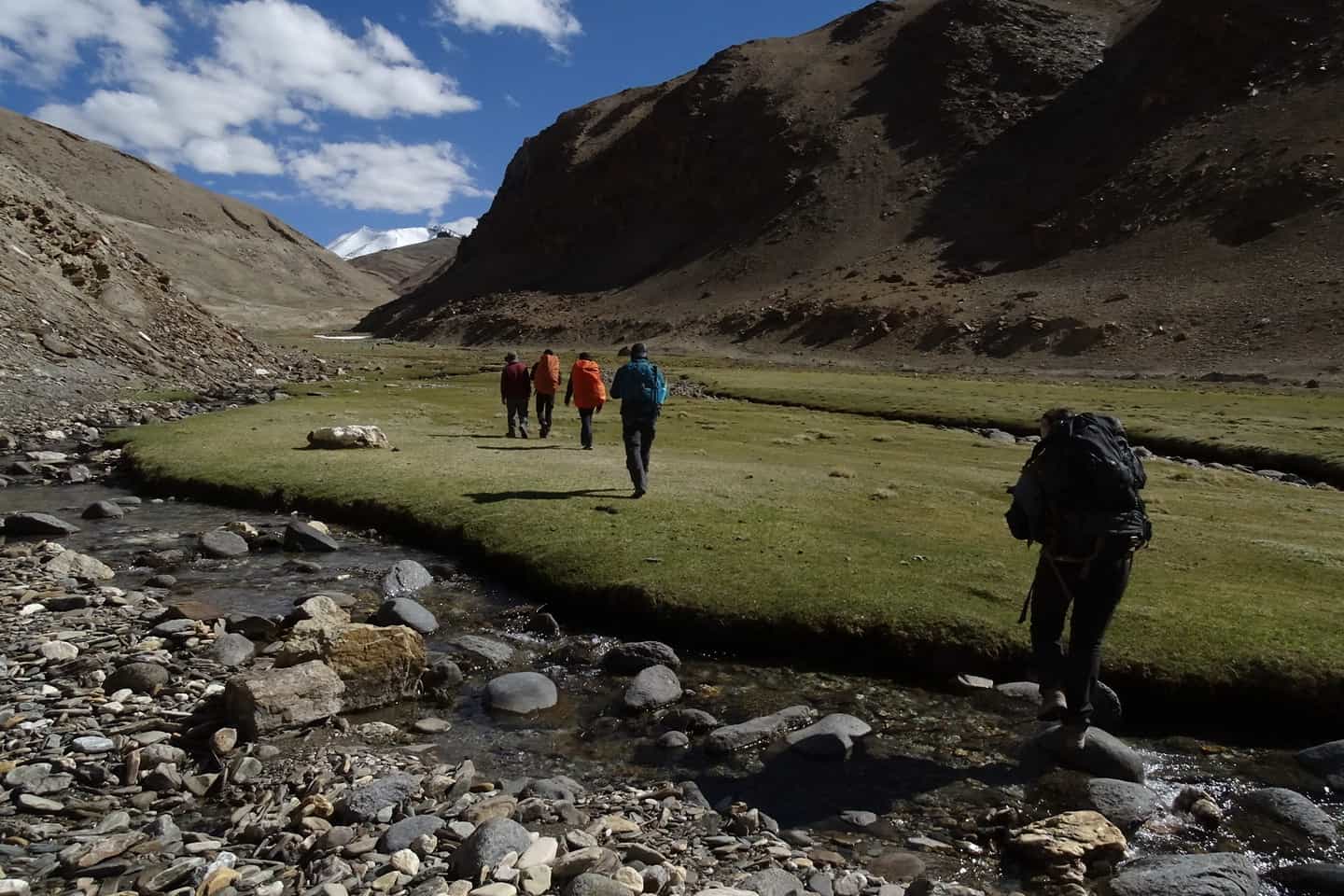
Hiking
Having completed the trek through the Markha Valley, and now well-acclimatised to the higher altitudes, it's time to ascend the Lato Valley on the approach to UT Kangri. Your trail follows old nomadic routes between several farming villages, exploring more of the traditional Ladakhi culture on your way to Rumtse Phu. Here, the locals are known for their horse riding and traditional dance of Gya-Pa-Cho. Although still in remote, high mountain terrain, both the villages of Lato and Rumtse Phu are connected by road, so they offer easy descent and evacuation options from the base camp of UT Kangri.
Day 10
Trek up to UT Kangri Base Camp (5300m)
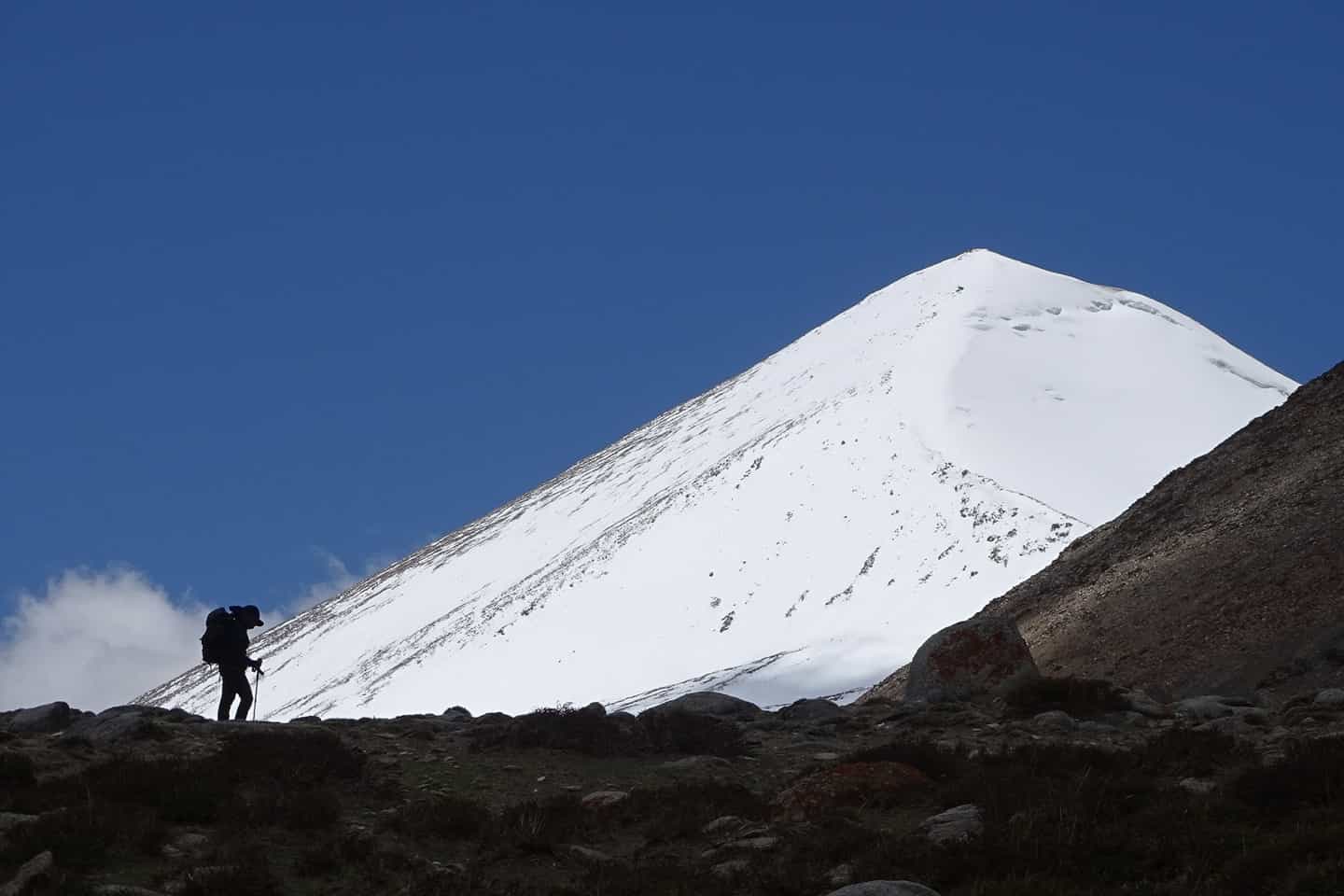
Hiking
Tackle the short but steep morning walk up to base camp, where you'll spend the next three nights. At over 5000m you'll need to take today slowly as your body acclimatises further. Enjoy views of surrounding unclimbed peaks and the green pasturelands below. After lunch, your mountain guide will deliver a session introducing you to the techniques you will use on the snowy slopes above, including walking when tied in to a rope and how to use crampons and ice-axes. In the evening, your group will venture on a short acclimatisation walk taking in the light of golden hour on the spectacular snowy peaks surrounding you.
Day 11
Mountaineering practice and acclimatisation day
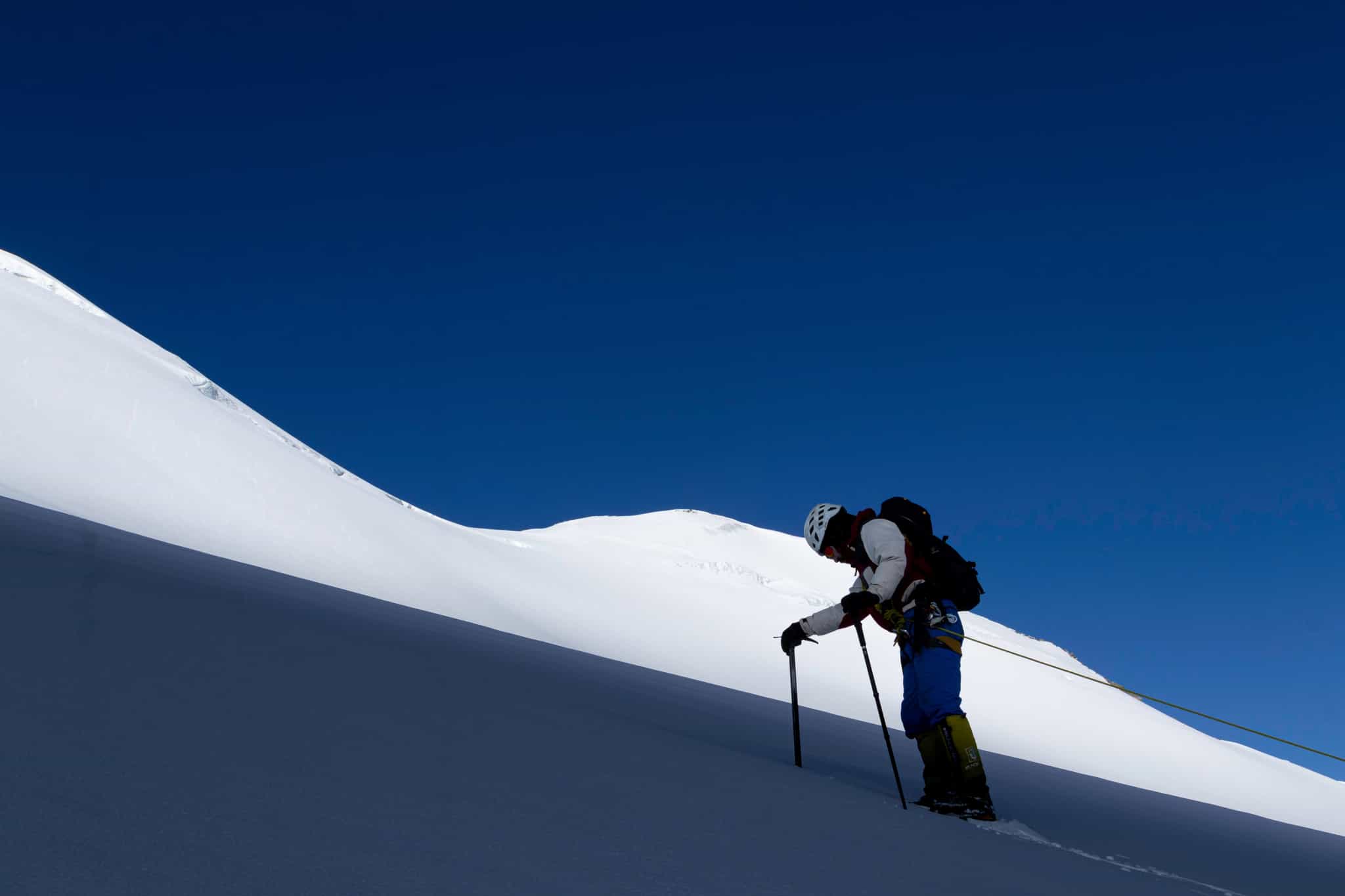
Hiking
Today is a chance to get to grips with the simple, but important, techniques required to reach tomorrow's summit. You will walk above base camp, up simple snow slopes and small peaks, learning how to use your mountaineering equipment and practice skills such as moving on steep terrain and self-rescue techniques. Returning to camp, you'll have an early dinner – time to get some sleep ahead of tomorrow's early start for the summit!
Day 12
Summit day!
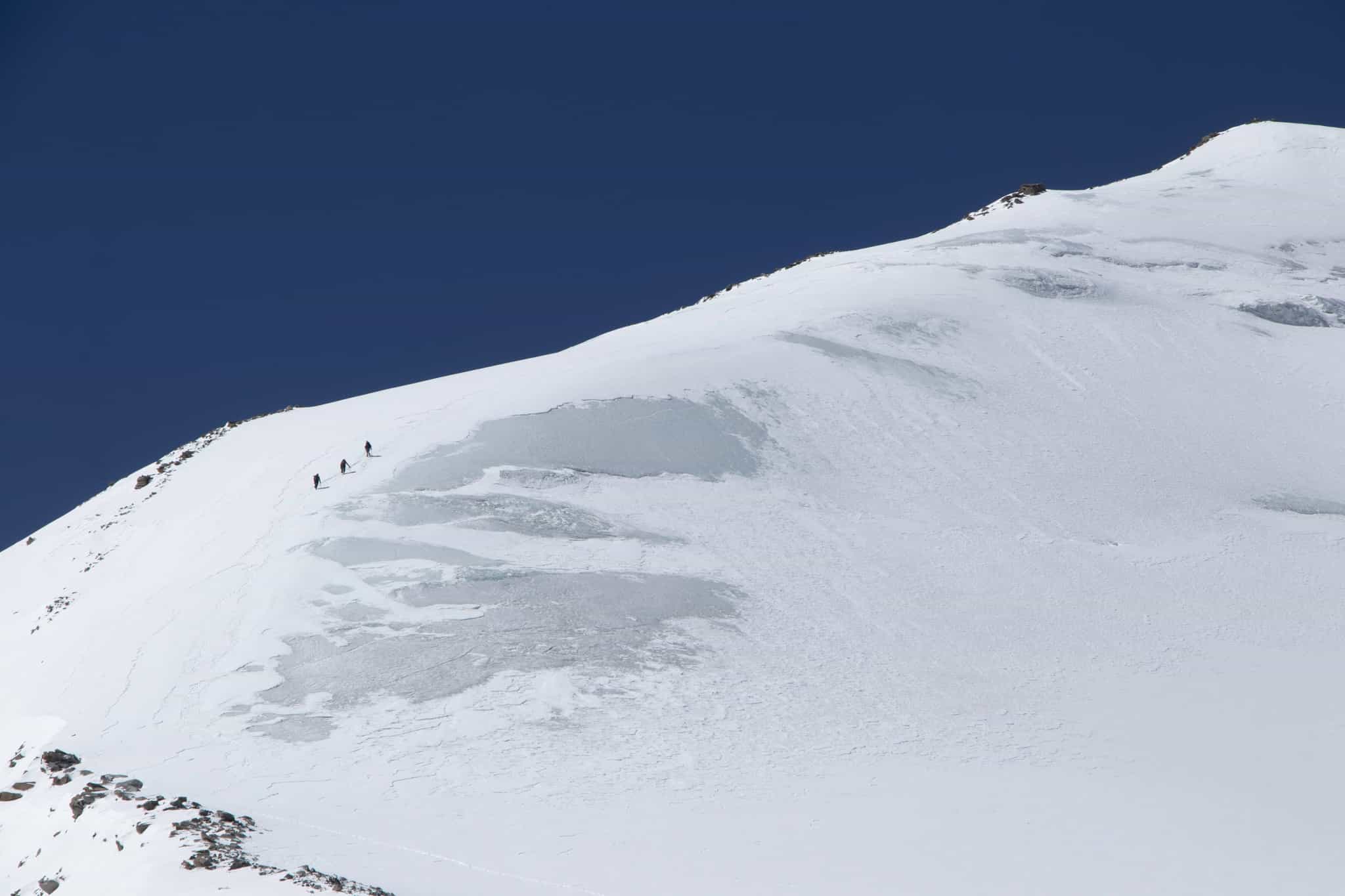
Hiking
The day you've been waiting for! Wake before dawn to start your summit bid. A challenging climb awaits as you ascend steep scree and moraine before crossing snow fields on the way to the top. You will be roped up with a mountain guide, at a 1:2 guide-to-climber ratio, using the skills you have learned to safely navigate the terrain. Finally, reach the summit at 6070m to be rewarded with views of Kang Yatse and many other high peaks of Ladakh. Take in the achievement of summiting a huge 6000m mountain before making the descent back to basecamp where you can enjoy a well-earned rest.
Day 13
Hike out and back to Leh

Hiking
Driving
Enjoy your last morning in the high mountains before hiking back down to Rumtse Phu, where you say goodbye to your trek crew and will be picked up for the return journey to Leh. There's one last stop on the way, at the Hemis Monastery, one of the largest and richest monasteries in Ladakh. The monastery dates back to the 17th century and is a colourful insight into Himalayan Buddhism. Arrive back to Leh in the afternoon, where you can check in to the hotel ahead of a farewell dinner with your fellow summiteers.
Day 14
Fly to Delhi
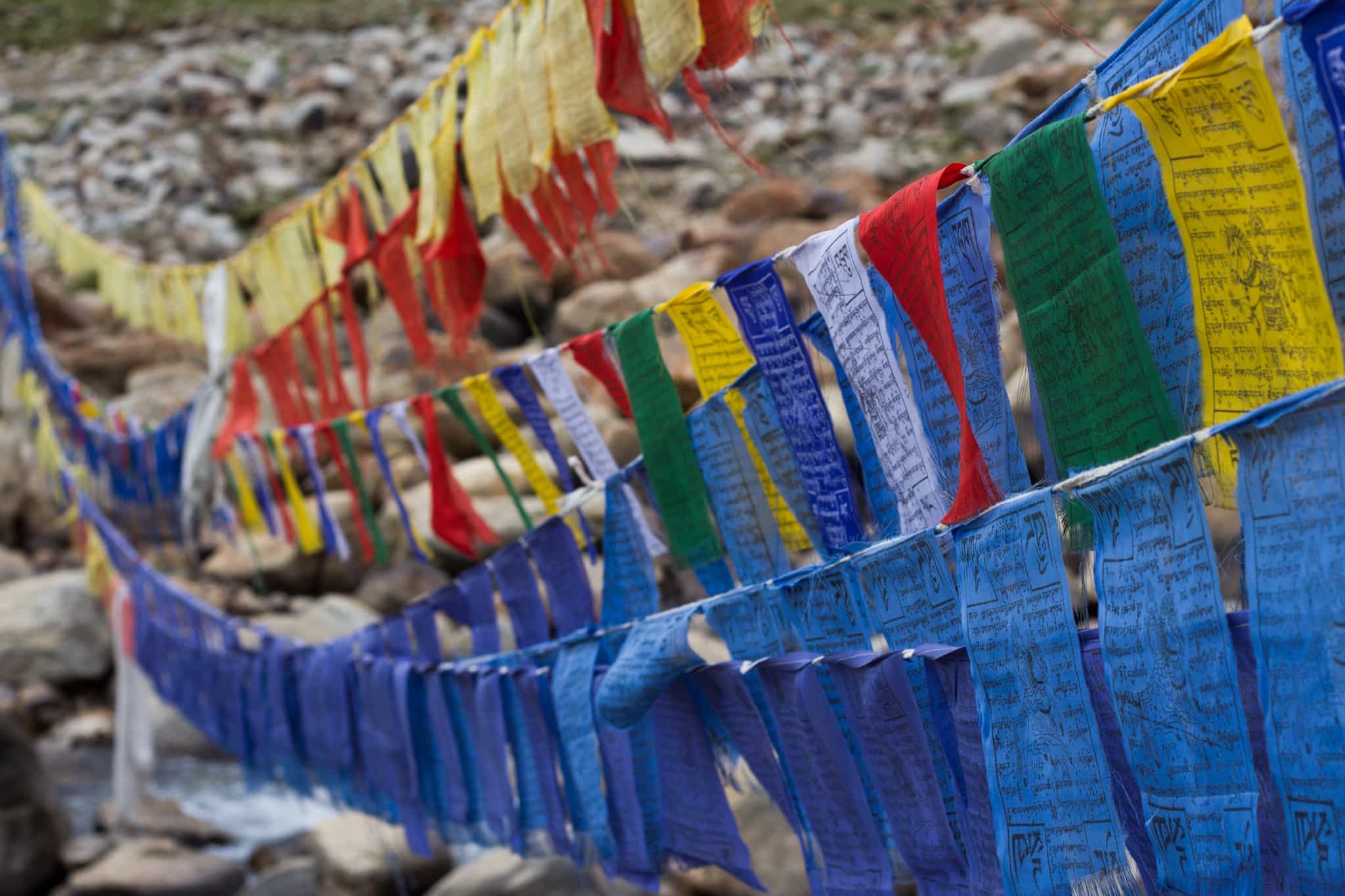
After breakfast, you'll be picked up and transferred to the airport for your morning flight back to Delhi Airport. From here, you may connect to your onward international flight or your host can arrange additional nights in Delhi.
The Area
Logistics
Starts
Indira Gandhi International Airport, Delhi
Any time on Day 1
Ends
Indira Gandhi International Airport, Delhi
Evening departure on Day 14
Transfers
Your host will meet you on arrival at the international airport in Delhi and transfer you to your accommodation in New Delhi. On the last day of your trip, you will fly back from Leh to Delhi Airport, where you can connect to your international flight.
An airport transfer is included in the main price if you arrive on Day 1. If you wish to arrive before the trip start date or stay longer at the end, your host can arrange private airport transfers and pre- or post-trip accommodation. See Optional Extras for prices.
Travel options
There are numerous direct flight options to Delhi with various carriers from the UK, Europe and the east coast of North America. Travellers from the west coast of North America will generally transit through major hubs such as London, Paris and Dubai.
Day 1
Breakfast
Lunch
Dinner
Day 2
Breakfast
Lunch
Dinner
Day 3
Breakfast
Lunch
Dinner
Day 4 – Day 12
Breakfast
Lunch
Dinner
Day 13
Breakfast
Lunch
Dinner
Day 14
Breakfast
Lunch
Dinner
What is the food like?
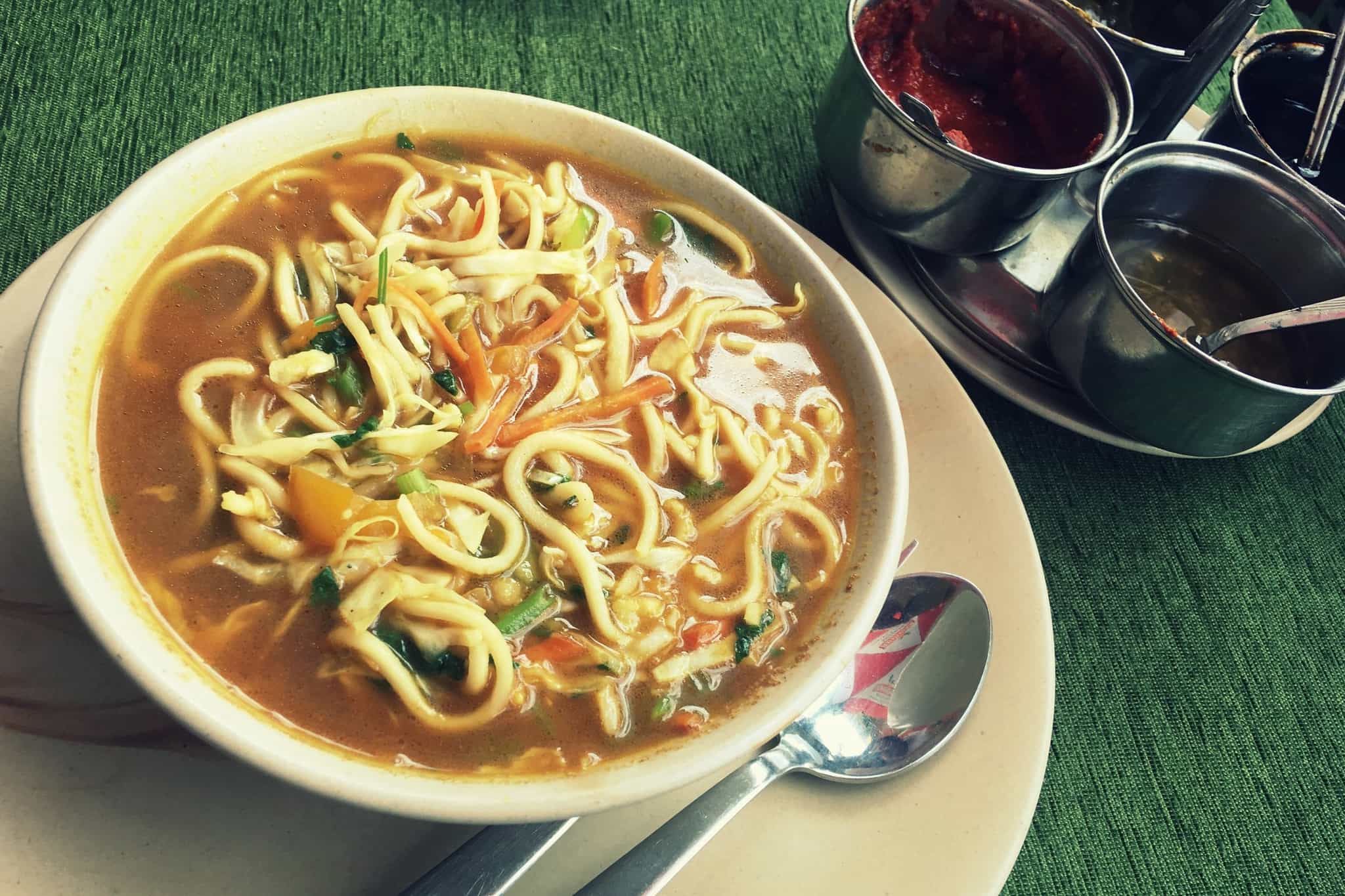
During the trek, breakfast, lunch and dinner will be prepared by the cook travelling with the group. Meals are a mix of international and local cuisine. Breakfast usually consists of porridge, cereals, eggs and toast with plenty of tea, coffee and hot chocolate. A picnic lunch will be taken on the trail during the day and could include soup, local bread, cheese, eggs, fresh vegetables, salad, tinned fish, meats and fruit. On arrival at camp in the afternoon, tea and biscuits will be provided. Dinner, served in a communal dining tent, will include a soup starter, pasta, rice or potato-based main courses with fresh vegetables, followed by dessert and hot drinks. Local cuisine like momos (vegetable dumplings) and thukpa (mixed vegetable noodle soup) will also be served on some days.
Vegetarians, vegans and other dietary requirements and allergies can be catered for – please just request this on your passenger info form.
What is the accommodation like?

Delhi
On the first night of your trip, you’ll stay in the Ashok Country Resort (or a similar hotel), located a few minutes from the airport in Delhi. Rooms will be allocated on a twin-share basis and have ensuite bathrooms, air-con, and WiFi. This family-run, boutique hotel also has a lush, green outdoor space with a pool.
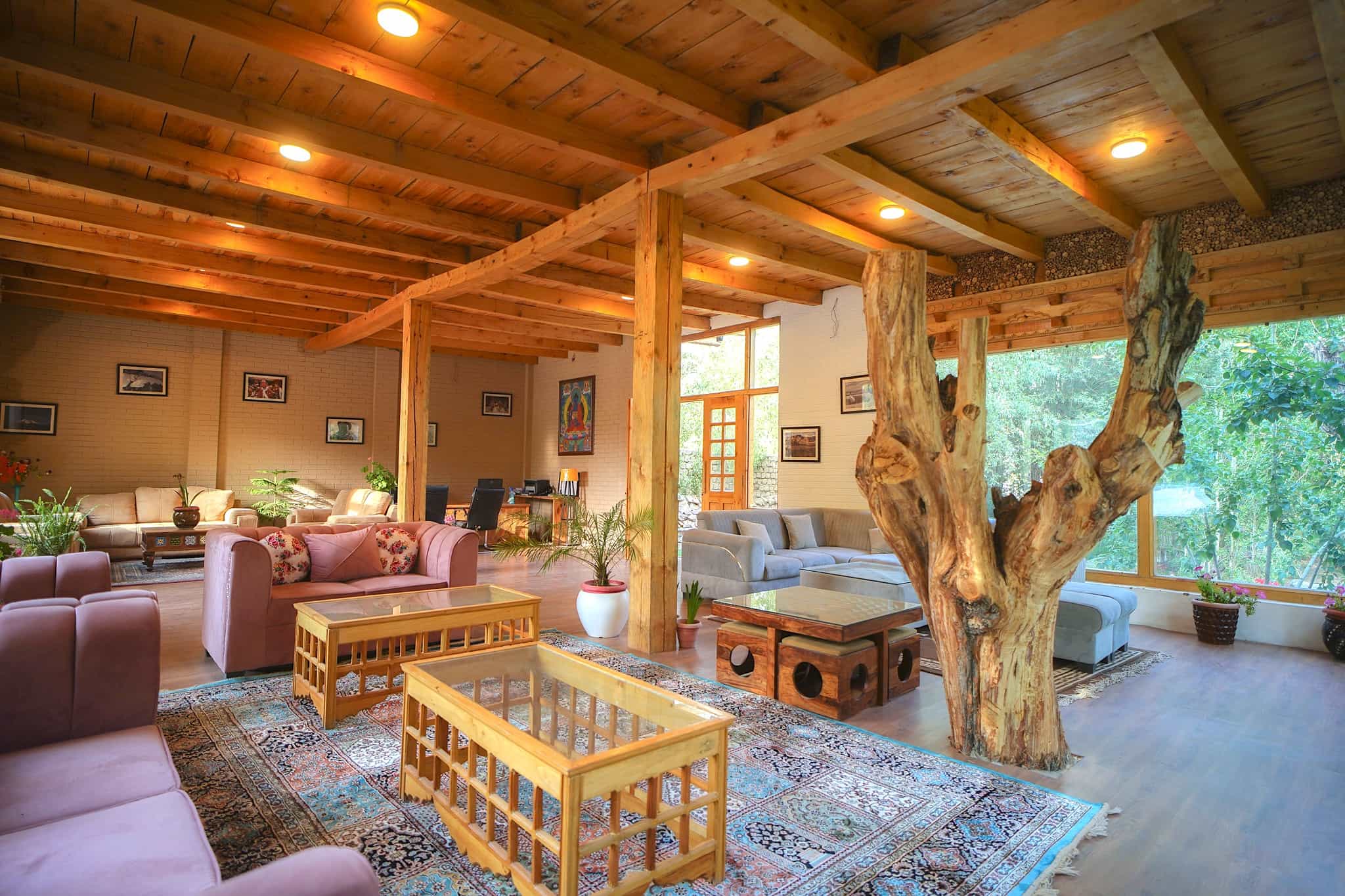
Leh
Whilst staying in Leh (Days 2, 3 and 13) you will stay in the Sangto Villa Resort (or similar), nestled in the heart of the mountains. You'll be in ensuite rooms on a twin-share basis.
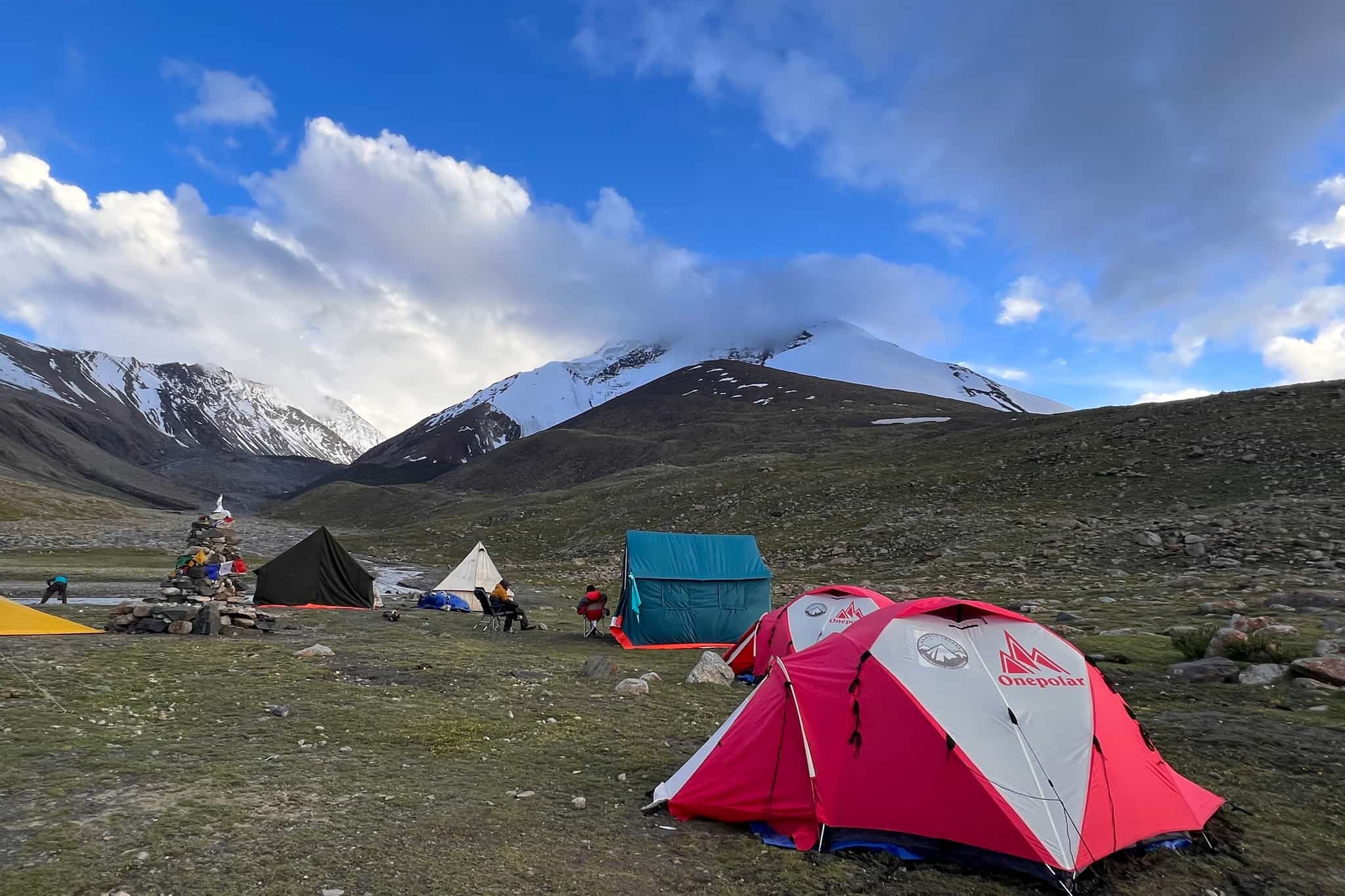
On the trek
Whilst you're trekking, you’ll camp in high meadows or on the edge of small mountain communities in twin-share tents. Your tent will be put up for you, and a comfortable camping mat is provided – just bring your sleeping bag! There will also be a tent provided for group meals. At the overnight camping spots, a toilet tent will be set up over a hole in the ground. Toilet paper will also be provided. During the day, toilet stops will generally be 'wilderness-style' with no facilities. For washing during the trek, the crew will provide you with a bucket of hot water and a mug (to use as a ladle) at the end of each day and if weather conditions permit a shower tent will also be erected for privacy. Each morning hot water will also be provided to wash your face and freshen up.
Upgrades
For solo travellers looking for their own space, an optional private room and tent can be booked – see Optional Extras. Please note this is subject to availability and must be requested at the time of booking.
This trip has been rated as Tough
To reach the summit of UT Kangri is classified as 'Tough'. You will need good levels of fitness and resilience, as well as experience of handling yourself in outdoor environments, in order to deal with the challenges of reaching 6000m. Previous experience in high-altitude mountain environments (above 4000m) is recommended.
UT Kangri is considered a non-technical trekking peak; as such, you don't need any special climbing skills, only an understanding of how to use an ice axe, crampons and ropes to safely move across steep winter terrain. During your acclimatisation day at base camp, your climbing guide will teach you these skills, required for safely reaching the summit. You will practice walking on crampons, ice axe self-arrest, moving on steep ground and how to move with your guide on a rope. However, undertaking an introductory winter skills course prior to this trip would be highly beneficial.
Climbing any 6000m+ peak involves challenges and hazards, please carefully read all of the trip information to be able to make an informed judgment on whether the challenge and inherent risks involved in this trip are for you. Our expert local guides have designed the itinerary with appropriate acclimatisation, rest days and contingency/evacuation plans in order to mitigate, although not eliminate, these risks. The guides are also trained to dynamically risk assess conditions on the mountain, as well as monitor the group for altitude-related symptoms to keep you as safe as possible. On summit day there is a 2:1 customer to guide ratio, plus additional helpers; allowing group members to safely descend to Base Camp if needed without the pressure of jeopardising the rest of the group's ascent.
Aside from the summit climb, trekking up and downhill every day for two weeks at high altitude is a challenge in itself and requires significant physical exertion. You should consider appropriate training for several months before the trip begins. Unlike many other peaks, UT Kangri offers a chance to attempt a 6000m peak without an excessively long summit day or post-summit walkout. This, combined with the beautiful Markha Valley trek prior to the climb, make it a trip that can be enjoyed by both those wanting to attain their first 6000m peak and those looking for a moderately challenging trek who could then relax in base camp for the morning of summit day before rejoining the group on the way down. The base camp sits at a similar altitude to Everest Base Camp.
What will I need to carry?
You'll only need to carry a small day rucksack (containing personal items, extra clothing layers, snacks and water) while hiking. On summit day, you'll also need to carry your ice-axe, harness, helmet and crampons. Your main duffle bag will be carried by ponies during the trek. Anything not needed for the trek can be left at your accommodation in Leh or Delhi.
In Ladakh, daytime temperatures in Leh can reach a high of 28°C, while UT Kangri Base Camp may see temperatures around 15°C during the day and as low as -5 to-10°C at night. Ladakh generally enjoys stable weather during the summer, but occasional rain or snowfall in the mountains is possible. The climb of UT Kangri may involve setting off before dawn in very cold conditions with the possibility of encountering snow. While departures are timed for good weather, conditions in mountain areas can be unpredictable, so it's essential to be prepared for any changes beyond the expected weather patterns.
During the summer season, Delhi experiences hot and humid conditions with temperatures around 35°C or higher.





What a trip!! The country,
What a trip!! The country, the Altitude, the colours, the geography. All compounded with fantastic hosting, knowledge and expertise. One of the best trips I've done which was organised very well with an expert itinerary which enabled the entire group to acclimatise and reach the end goal.

Incredible trip
My 4th MBA trip and this was just incredible - completely disconnected from the world for 10 days, trekking over beautiful valleys and mountain passes, to reach the summit of UT Kangri. The whole team did a wonderful job - the food was delicious, camping spots were spectacular and we were all so well looked after by our guides Dorjee and Jikmet. Couldn’t recommend this trip more for anyone who’s new to mountaineering and wants to summit a 6000’r.
UT Kangri Adventure
This trip was amazing! The local guides were really knowledgeable and made you feel really safe. The trek was tough but it was well planned to help with a gradual acclimatization so everyone managed to make it to the summit. I would definitely recommend this trip to anyone who wants a new adventure.







Fantastic trip
I loved this trip and would highly recommend it! The itinerary, organisation, staff and scenery were incredible!
Beautiful and remote trek in Ladakh
Overall one of the best multi day trekking experiences I have had. The route was very good, combining both local villages and more remote nature. The summit experience was unbelieveable and a perfect challenge!



Exceeded High Expectations
This is one of the trips that can/will change your life. Be prepared to push your limits of comfort as you navigate through the intriguing Markha valley.
You will be astonished at the continued selflessness of the crew. From somehow whisking together high-altitude pizzas, cakes and pies to spending hours with shovels and bare hands during a sub-freezing snowstorm to ensure campsites were perfectly level, there is no bound to their service. All that’s left to do is put one foot in front of the other and make it into the dining tent on time.
To my fellow trekkers, I am filled with endless gratitude. May the road go on forever and the party never end. Juley juley!
Note: I only recommend this trip for folks who have experience with remote multi-day trekking and camping in cold temperatures above 5km.







Incredible
This was such an amazing experience - we had a really fun group of 6 trekkers, with an absolutely incredible support team and guides. The scenery was out of this world, and we really felt a great sense of achievement when we summited UT Kangri! It was a stunning climb up through a cloud inversion over the whole Eastern Karakoram. Our guides were really great at making sure we were well acclimated to the high altitudes, and it was a beautiful trek overall. The food was amazing, especially considering it was a camping trek, and the tents were surprisingly spacious! One touched I LOVED was that our guides gave us hot water bottles at night, which meant we slept really well - it was a real treat. If you are considering doing this trip, just say yes and book it! You won't be disappointed. Ladakh is an absolutely incredible place with the friendliest people.





I’ve used MBA for a
I’ve used MBA for a number of trips and I keep coming back again and again because of the combination of ease, organisation and access to new places that they provide. This trip in particular stands out even amongst the others - leh offered a fantastic base for the trip with a much more relaxed atmosphere than other areas of India Ive experienced, the local team on the ground ( majestic ladakh) offered all the support that you could want and the acclimatisation schedule on the trek meant that we saw 100% of the group summit despite it being the first time any of us had gone up above 6000m.
Itinerary Activities
- Acclimatisation hike to Thiksey Monastery in Leh
- 6 days of guided hiking through the Markha Valley
- Guided hike to to UT Kangri Base Camp (5300m)
- Acclimatisation day with mountaineering skills session
- Guided climb to the summit of UT Kangri (6070m) and descent to base camp
- Guided descent to Rumtse Phu, with a visit to Hemis Monastery
Guides
- Expert, local, English-speaking tour leader and trekking guides
- Mountain guides at a 1:2 guide-to-climber ratio on summit day
Accommodation
- 1 night in a hotel close to the airport in Delhi
- 3 nights in a mountain hotel in Leh
- 9 nights camping in high meadows or on the edge of small mountain communities – your tent will be put up for you
Meals
- All (13) hot breakfasts
- 10 picnic lunches
- All (13) homemade dinners
Internal flights
- Morning flight from Delhi to Leh on Day 2
- Return flight from Leh to Delhi on Day 14, where you can catch a connecting evening flight home
Transfers
- Arrival transfer from Delhi Airport at any time on Day 1
- All transfers during the trip
Porterage
- Pack horses will carry your overnight luggage on the trek
Equipment
- All climbing equipment (except boots)
- Tent and camping mat
Permits
- All entrance fees and permits
Our trips are hassle-free by design. We include all the activities and equipment, as well as many of the meals, so you can simply rock up with your rucksack and share the adventure with your new pals.
Travel to and from the trip
Our trips do not include flights, trains or other travel to the start point and back from the end point.
Tips
Tips are not included in the trip cost. These are entirely at your discretion but there is an expectation to tip for good service. Your tour leader will help with advice regarding how the tips are split between guides, cooks, muleteers and helpers, however we suggest as a guideline approximately £150 per person for the full trip.
Of course, you are free to tip more or less, and the amount should be reflective of your perception of service and quality – a tip is not compulsory and should only be given when you receive excellent service.
Personal Expenses
You know your own spending habits best, so please budget an appropriate amount for things like optional meals and drinks, shopping, optional activities, and laundry.
Travel insurance
Travel insurance is compulsory for all of our adventures, and you'll need to provide your policy details before departure. Your insurance should offer adequate cover for overseas medical treatment, evacuation/repatriation, your baggage and equipment, and the specific activities involved in your adventure. We also recommend ensuring your policy includes cancellation and curtailment cover, in case you're unable to join your trip due to unforeseen circumstances such as illness.
Standard travel insurance may not cover all the activities included in your adventure, so it's essential to check the details carefully. There are adventure-specific providers that many travellers have used in the past, such as True Traveller (for those based in the UK or Europe), or Rise + Shield, both of which offer cover for a wide range of adventurous activities.
Please make sure your chosen policy meets your individual needs and covers all aspects of your trip.
Visas
Visa requirements often change, and you are responsible for obtaining any required visas for this trip. Please check with your nearest embassy or consulate for up-to-date advice.
What's included?
- Sleeping tent and mattress (you may choose to bring your own inflatable mattress and pillow for extra comfort)
- All climbing equipment: ice axe, climbing helmet, harness, carabiners, crampons
Please note, you'll need to bring your own climbing boots (see footwear section below).
Although the below items below are included and can be provided locally, we advise you to bring your own for extra comfort and better fit:
- General mountaineering crampons (modern steel 12-point crampons with anti-balling plates)
- Climbing harness
- Carabiners (3 lock, 2 unlock)
What do I need to bring?
BAGS
- 1 duffle bag (70/80 litres)
- 1 daypack (approx. 40/45 litre) with hip belt, waterproof cover and ice axe loops
Please pack no more than 10kg per person of clothing/personal items (including your sleeping bag) in a soft backpack or duffel bag, allowing for the climbing equipment to make up the remainder of the porterage limit. You will only need to carry a daypack with essentials in (an extra layer, snacks, water, suncream, camera etc.).
CLOTHES
Mountain environments are notoriously unpredictable. A layering system works best so that you can put on and remove items to adjust your temperature. You'll need to be equipped for all eventualities, although you won't necessarily need to use everything if you're lucky with the mountain conditions.
- 1 set of base/thermal layers (merino is ideal)
- 1 mid-layer/hoody (fleece or similar)
- 1 outer layer/hardshell jacket
- 2 sets of merino tops
- Waterproof trousers and top (Gore-Tex is ideal)
- 1 pair lightweight trekking trousers or zip off trousers
- Fleece trousers or hardshell trousers
- Insulated trousers
- Hiking shorts
- 2 trekking t-shirts/shirts (merino is ideal)
- Four-season down jacket with helmet-compatible hood (comfort rating down to around -20°c)
- 1 pair liner gloves
- 1 pair softshell gloves
- 1 pair insulated shell gloves
- Underwear
SLEEPING
- Four-season sleeping bag with hood (with a comfort rating down to around -20°c)
- Sleeping bag liner (a good liner can add a few degrees extra warmth)
- Pillowcase and own mattress (optional)
FOOTWEAR
- Worn-in hiking boots
- Mountaineering boots (double layer recommended e.g. G2 La Sportiva boots)
- Trainers
- 2 pairs liner socks, 3 pairs of mid-weight socks, 2 pairs warm mountain socks
- Gaiters
You can read more about crampons and selecting the right boots here.
HEAD
- 1 warm wool hat
- 1 Buff or similar
- 1 warm scarf
- 1 sunhat or similar
- Sun/glacier glasses (Category 4, ideally with a 'wrap-around' design)
- Ski goggles
- Head torch
- Balaclava
TOILETRIES
- Travel towel
- Sun cream (high SPF: 50+)
- Hand gel
- Moisturiser
- Lip balm (high SPF: 50+)
- Face wash
- Mouthwash
- Toilet paper
- Soap
- Shampoo
- Pee bottle for men/plus a pee funnel for women
OTHER
- 2 x 1 litre water bottles plus an optional CamelBak
- Small biodegradable bags to take toilet tissue off the mountains
- Mobile charger
- Universal plug adaptor
- Personal medication and first aid kit
- Earplugs
- Power bank
- 1 small roll of repair tape
- 1 sewing/repair kit
- 1 small folding knife
- Thermal flask
- Adhesive hand or toe warmer
- Universal plug adaptor
- Book/Kindle/playing cards, for downtime
- Passports (and visas)
- Travel insurance documents
- Energy bars and snacks - read our article on Best Hiking Snacks
- Water purification tablets/treatment system
It is recommended that you contact your host at least one month prior to your trip if you have any doubts regarding the kit list.
Please also remember to remove all unnecessary packaging before you leave home and ensure you take all plastic off the mountain to be disposed of in Leh.
Pre/post trip accommodation in Delhi (single)
Payable Before Departure
Pre/post trip accommodation in Delhi (single)
… Per person, Per night
Pre/post trip accommodation in Delhi (double / twin)
Payable Before Departure
Pre/post trip accommodation in Delhi (double / twin)
… Per night
Optional Private Room & Tent Upgrade
Payable Before Departure
Optional Private Room & Tent Upgrade
… Per person
Private airport transfer - each way
Payable Before Departure
Private airport transfer - each way
… Per person
We partner with the World Land Trust to ensure this trip achieves Net-Zero emissions. We also support their Buy an Acre programme, helping local communities to buy and protect natural habitats in perpetuity.
What's the number?
It works out on average at 383kg of CO2 emissions per person, including all local transport, accommodation, food, activities, guides, staff and office operations.
The only thing it doesn’t include right now is flights and travel to the destination. We do make an overall estimate across all our customers separately, but as we don’t book flights, have customers from all corners of the world, and no way of reliably knowing their travel plans, we simply can’t include an individual number in the figure on display here. We’ve got a goal to fix that, so that when you book, there is a way to measure and mitigate the carbon emitted by your flight too.
But what does the number mean?
Yep, hard to picture eh? To give you an idea:
- Driving 1000 miles/1609km would be approximately 281kg of CO2 in an average car (or 140.5kg per person, if there were two of you in it).
- A return economy class flight between London and New York would be approximately 1619kg (1.66 tonnes) per person.
- 10 trees in a temperate forest are estimated to remove approximately 250kg of CO2 from the air in a period of 5-10 years.
What are we doing about it?
Our trips are relatively low-carbon by design, and we're working with all our hosts to develop long term carbon reduction plans. We partner with the World Land Trust to ensure this trip achieves Net-Zero emissions. We also support their Buy an Acre programme, helping local communities to buy and protect natural habitats in perpetuity, ensuring the protection of the reserve and its wildlife.
Want to know more?
Amazingly, no international travel company has ever publicly published their carbon measurements before, as far as we know. We believe that must change, quickly. So we’re openly sharing the method we used in the hope that other companies will be able to more easily follow suit and build on what we've done so far. You'll find it all here.
Stok Kangri used to be a very popular 6000m trekking peak in Ladakh, but was closed by the Indian Government for environmental reasons. Overtourism and poor environmental management from trekking groups caused water sources to become contaminated, and the government stepped in to protect the local village below base camp. Trekking and adventure tourism is an important source of income for these rural areas and following this closure, the Ladakh Mountain Guide Association searched for a more sustainable alternative. UT Kangri was brought on as a trekking peak by the Ladakh Mountain Guide Association in 2019, allowing trekkers to continue tackling a 6000m peak without degrading the environment and ensuring an income from sustainable tourism for local communities. UT Kangri is a good introductory peak for this altitude, as it is not overly technical and has a relatively short summit day. Very few trekkers have as yet had the opportunity to summit UT Kangri, so this is a unique achievement and you’ll be in a pioneering minority.
Your host works with some of the best leaders in the industry. Every single one of them is government-licensed and very experienced. In order to ensure the guides' high standard of performance, all the host's guides and assistant guides are members of the Ladakh Mountain Guide Association, as well as being certified with basic and advanced mountaineering certification from leading mountaineering institutes such as the Himalayan Institute of Mountaineering. The lead guides hold international standard Mountain Emergency First Aid and Avalanche Rescue training from Osterreichischer Bergrettungsdienst.
You will be joined by one tour leader from the trip start to end, as well as a local trekking guide and crew including a cook, helpers and muleteers when on the trek. For the skills preparation and summit days there is a customer-to-guide ratio of 2:1.
Summit day
The guide will determine group divisions based on walking pace when reaching Base Camp and will arrange the necessary connecting ropes, ensuring there is at least one assistant climbing guide for each group. If any group member becomes unable to proceed to the summit, they will receive assistance from an assistant climbing guide in the case of small groups. This arrangement will not hinder the progress of the rest of the group.
Filtered and boiled water will be provided during the trek. You will need to bring a reusable water bottle or a water bladder to be filled.
Excess luggage which is not needed for the trek can either be left at your hotel in Delhi or Leh, then picked up on your return.
This trip operates at times of the year with high chances of favourable conditions to complete your summit climb. However, as with any high-mountain adventure, conditions can be changeable and unpredictable. Our local host holds contingency plans, including alternative routes and objectives (e.g. in the case of late-season snow blocking a pass). In the event of adverse weather conditions, your lead guide will make a decision on whether any of these plans can be implemented or to return to Leh, prioritising the safety of the group and field staff. Proceeding with any contingency plan, differing from the main route, will require mutual agreement from the group.
Your luggage will be carried by ponies, in large waterproof sacks. However, it is worthwhile securing your luggage in a waterproof bag or duffel to ensure it stays dry in transit. You should aim to keep your luggage as light as possible, not exceeding 15kg (including the 3-5kg of climbing equipment).
The luggage weight limit for your internal flight is 15kg, plus one piece of hand luggage up to 7kg. Excess luggage fees are payable locally to the airline.
This trip reaches elevations above 4500m, where the risks associated with Altitude Sickness (AMS) are higher, and where more serious conditions like HAPE (High Altitude Pulmonary Edema) and HACE (High Altitude Cerebral Edema) can occur.
Previous high-altitude experience doesn’t guarantee the same reaction every time, but it can be a helpful indicator. It gives you insight into how your body might respond, helps you recognise symptoms early, and prepares you mentally and physically for the demands of high-altitude trekking.
Your guide is trained to manage altitude risk by carefully managing the rate of ascent, monitoring group wellbeing, and taking action if anyone becomes unwell.
Before travelling, think about your own physical condition and consult a medical professional if you have concerns – especially if you have underlying health issues. If possible, arriving a day or two early at altitude is a great way to help your body adjust.
Your travel insurance must cover the maximum altitude reached on this trip and include emergency evacuation.
This trip includes locations or elevations where conditions can be extremely cold. Daytime temperatures may drop below freezing (0°C/32°F), and nights are often significantly colder. These conditions can affect physical performance and increase the risk of exposure-related issues, such as frostbite or hypothermia.
Your guide is trained to manage these risks, adapting activity intensity and monitoring group wellbeing. However, it's important to take personal responsibility – bringing the right cold-weather gear (see Kit List), staying hydrated and well-nourished, and recognising early signs of cold stress.
We recommend assessing your personal comfort and resilience in cold environments, and consulting a medical professional if you have health conditions that may be affected. Arriving early can also help you acclimatise to the colder conditions, especially if you're coming from a much warmer climate.
Visa requirements often change, and you are responsible for obtaining any required visas for this trip. The following advice may be subject to change. Please check with your nearest embassy or consulate for up-to-date advice.
All foreign nationalities entering India require a valid visa, which in most cases must be obtained in advance of travel (please check the regulations for your nationality). You must have a machine-readable passport, valid for at least 180 days from your arrival date in India. Persons of Indian origin must have an OCI card. Clients with a Pakistani passport or of Pakistani descent will need extra time and additional documents for visa processing.
Applicants of eligible countries can either apply online for an Indian e-Visa or apply for a Standard Visa, which involves an in-person visit to a branch of the Indian High Commission's Visa Facilitation Service (VFS). There have been delays to Standard Visa processing times so please book your appointment ASAP if using this service.
Travellers eligible for an e-visa, which includes those from the UK, US, CA and EU, can apply online via https://indianvisaonline.gov.in/evisa/tvoa.html. Applications for 30-day e-Tourist visas can be made from 30 days before the proposed date of travel and not less than 4 days before your arrival date in India (applications for multiple entry 1-year e-Tourist visas can be made from 120 days in advance).
Applications for a Standard Visa (requiring both an online application and an in-person appointment) can be made via the VFS Global website.
You’ll also need to complete an e-arrival card online before travelling to India. This digital form replaces the paper arrival card (still accepted until March 2026) and can be completed up to 72 hours before arrival. It’s not a visa, and a valid visa or OCI card is still required. More details are available on the Indian visa website.
Sure can! Over 70% of our travellers travel solo, it’s a great way to meet like-minded people.
Our team of Adventure Hunters co-create exclusive adventures which are run by highly vetted, specialist hosts. The trip is run by our trusted host partner in the destination. We only work with independent, local, in-destination experts who know the very best places to explore and how to stay safe. Read more information about the local teams we partner with. You’ll be introduced to the host straight after making a booking via the Much Better Adventures platform.
Much Better Adventures refer to the UK Government’s official travel advice when designing trips and monitoring trip operations. We recommend that all customers are familiar with the practical information provided on the Government’s FCDO website, where current travel advice can be found by searching for the applicable destination(s).
For customers joining this trip from other international destinations – please also read the official travel advice applicable to your country of residence/origin, as this may differ.
We recommend checking out the country-specific information and also talking to a travel nurse.
We automatically convert prices from the local currency that a host receives to your chosen currency. We update our exchange rates on a daily basis so this does mean that prices displayed on the site are subject to currency fluctuations, which is why you may see them change over time.
If you wish to change the currency you pay in, head to the bottom of the page.
All of our group adventures are specially designed for adults to enjoy as we want these adventures to bring together outdoorsy people who are truly like-minded. You must be over 18 to join one of our trips.
You're always in good company on one of our adventures.
Our trips are typically made up of a mixture of solo travellers and small groups of 2 or 3 friends, with most in their 30s-50s.
Our sociable adventures are solo-friendly by design and naturally attract outdoorsy people with a shared mindset; a love for adventure, a desire to push themselves and meet awesome, like-minded people along the way. Check out our Community Values – a shared code to make sure that everyone's experience is safe, inclusive and brilliantly unforgettable.
It’s this camaraderie that has so often turned a great adventure into a life-changing one.
Don't just take our word for it:
- 95% of people rate the group dynamics on our trips 5/5
- 90% of people recommend joining a trip to make new friends
- 75% of people have met people on our trips that they would now consider friends
See here for more info about the Much Better Adventures tribe.
Reviews

What a trip!! The country,
Adam S. September 2025

Incredible trip
Amelia S. September 2025

Fantastic trip
Sarah G. July 2025

Exceeded High Expectations
Desiree G. June 2025

Incredible
Katherine W. June 2025

I’ve used MBA for a
Alexander R. June 2025
UT Kangri Adventure
Kate O. July 2025
"This trip was amazing! The local guides were really knowledgeable and made you feel really safe. The trek was tough but it was well planned to help with a gradual acclimatization so everyone managed to make it to the summit. I would definitely recommend this trip to anyone who wants a new adventure."
Beautiful and remote trek in Ladakh
Jenny H. July 2025
"Overall one of the best multi day trekking experiences I have had. The route was very good, combining both local villages and more remote nature. The summit experience was unbelieveable and a perfect challenge!"
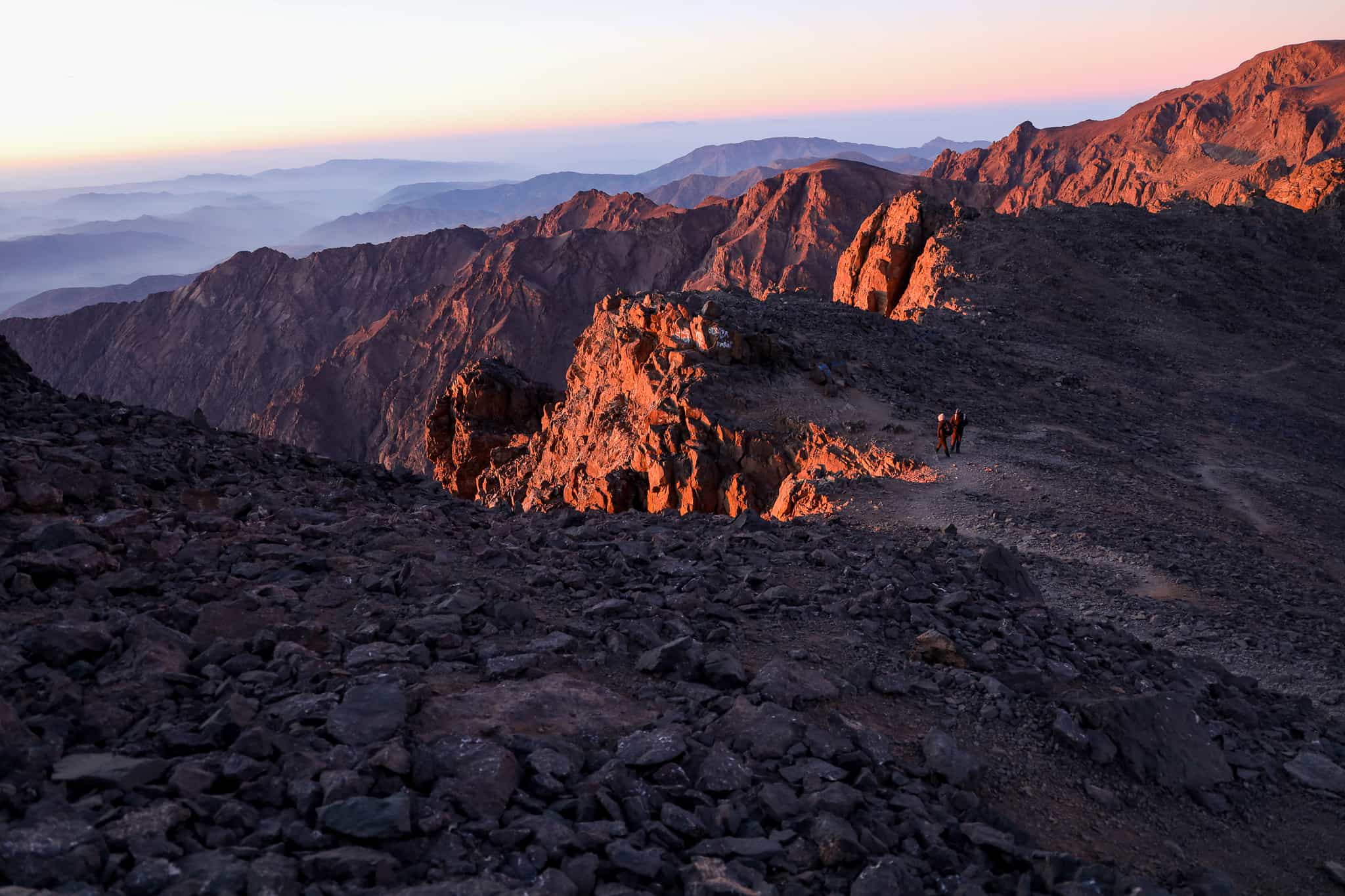

How fit do you need to be?
Every trip is different. Our friendly experts are here to help, whether it's about altitude, terrain, or recovering from injury.
We've got your back
Guaranteed to run
All Much Better Adventures trips are now guaranteed to run. Once you’ve booked your spot you can immediately make your travel arrangements, no uncertainty, no hanging about (excludes 'request to book' departures). Full details
Flexible payments
Secure your spot with the minimum deposit and pay off the remaining balance in as many instalments as you like, with no interest or fees. Full details
Happiness Guarantee
We’re so confident you’ll have an amazing time we’ll put our money on it. Full details
Full financial protection
To give you complete peace of mind Much Better Adventures is backed by ABTOT, ABTA and ATOL memberships. Full details
Tried & Trusted
Much Better Adventures is consistently rated ‘Excellent’ on Trustpilot with over 1000 verified trip reviews.
Connect before you go
You'll be invited to join a WhatsApp group to get to know each other before your big adventure together. Full details
DEPARTURE DATES
Saturday 23rd May 2026
to Friday 5th June 2026





